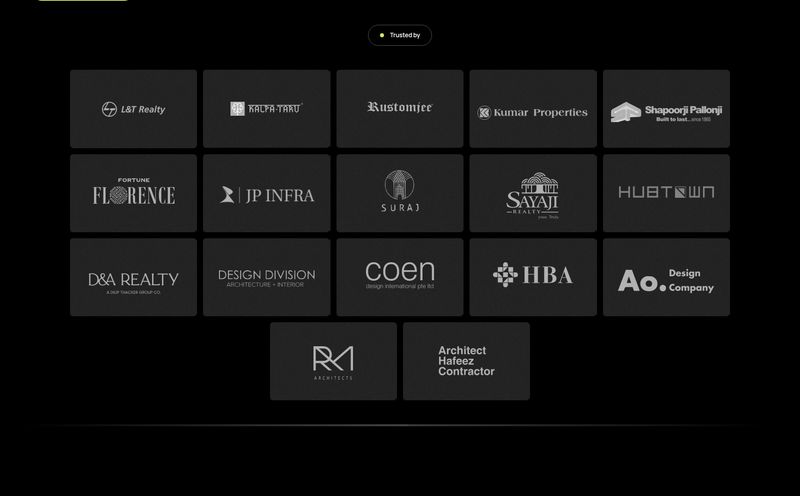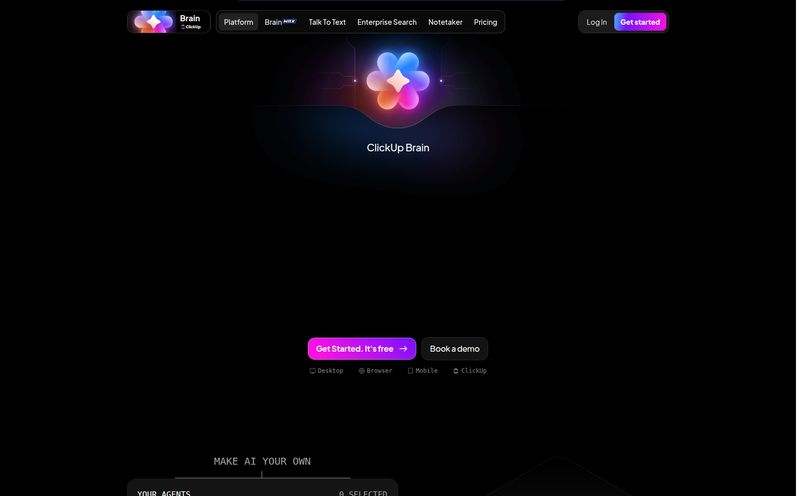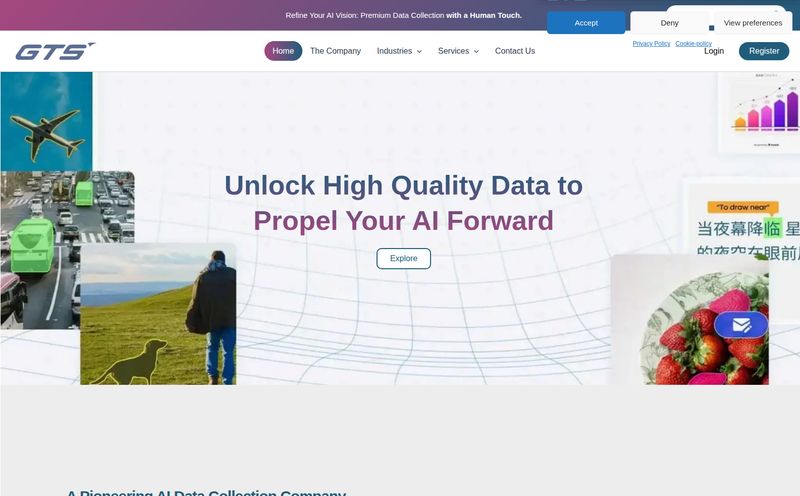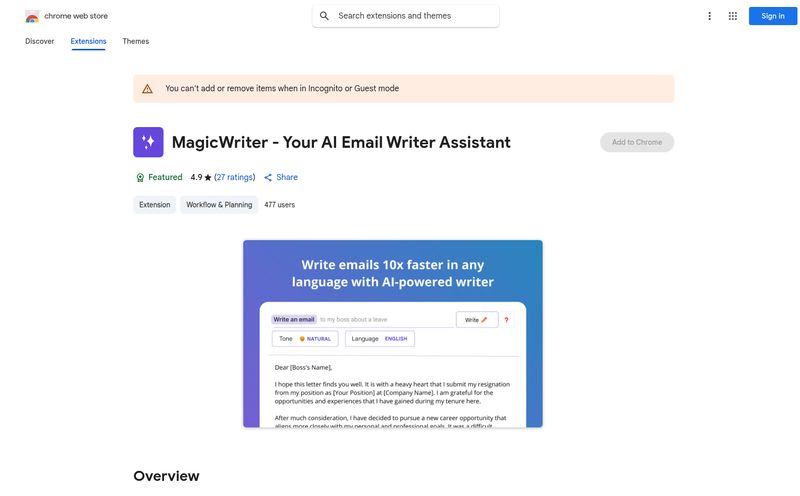I still get a cold sweat thinking about it. A few years back, we were running a massive CPC campaign for a client launching a new gadget. Everything was perfect. The ads were converting, the buzz was building, and then… poof. The main component manufacturer, a company nobody had ever thought to worry about, went offline. Factory fire. Just like that, the entire launch, and millions in ad spend, went up in smoke. We were all left scrambling, trying to explain to a furious client why our digital strategy didn't account for a factory burning down halfway across the world.
Ever since then, I've been obsessed with the fragility of the systems we all rely on. The modern supply chain isn't a chain; it's a spiderweb. A beautiful, intricate, and terrifyingly delicate spiderweb. A single tremor—a geopolitical spat, a new regulation, a ship getting stuck in a canal—can send catastrophic vibrations through the whole thing. So when I come across a tool like Infis AI, which calls itself an "AI-Powered Supplier Command Center," my ears perk up. Is it just another fancy dashboard, or is it something more? Something that could have seen the smoke before the fire?
So, What Exactly is Infis AI Supposed to Do?
Let's cut through the marketing jargon. At its heart, Infis AI aims to be a predictive radar for your entire supplier network. It’s not just about tracking orders or payments. It's about seeing the future. Or at least, seeing the most probable future based on an insane amount of data.
Imagine a system that hoovers up all your internal data—the stuff in your ERP, your CRM, production stats, audit reports, you name it. Then, it mashes that together with external signals from over 100 different dimensions. We're talking financial health reports, compliance history, delivery performance, and even geopolitical sentiment. It's looking for the digital smoke signals, teh tiny tremors that predict a bigger earthquake is coming.

Visit Infis AI
It then boils all this down into a live, constantly updating risk score for every single one of your vendors. It's less of a static report and more of a living, breathing assessment of your supply chain's health.
The Features That Actually Matter
A feature list is just a list. What I care about is what it does for you when you're in the trenches. After digging into what Infis AI offers, a few things really stood out to me as being genuinely useful, not just fluff for a sales deck.
The 'Crystal Ball': Real-Time Risk Scoring and Early Warnings
This is the core of the whole thing. The platform assigns a live risk score to each supplier, kind of like a FICO score but for operational reliability. It’s not a once-a-year review; it's continuous. The AI is designed to catch what they call "fast-moving risks." Think sudden factory shutdowns, new regulatory actions that affect a supplier, or a key shipping lane getting disrupted. It's built to warn you about the problem child in your network before they miss their first delivery, giving you time to actually do something about it.
Your Plan B, C, and D: Smart Sourcing Alternatives
Okay, so the AI flags a supplier as high-risk. Great. Now what? This is where, in my opinion, Infis AI gets really interesting. It doesn't just leave you with the problem. It actively suggests pre-vetted, low-risk alternative suppliers. This moves it from a simple monitoring tool to a strategic solution. The amount of time and panic this could save is immense. No more frantic late-night searches for a new parts manufacturer. The system has a vetted list ready to go. That’s not just risk mitigation; it’s a competitive advantage.
No More Silos: Centralized Intelligence and Seamless Integration
Here’s the part that will make any IT or Operations manager breathe a sigh of relief. One of the stated pros is that there are no workflow changes required. I've seen so many powerful platforms fail because adopting them was a nightmare. Infis AI is built to plug directly into the systems you already use—your ERP, CRM, even IoT data streams. It centralizes all that supplier intelligence in one place, breaking down the data silos that often prevent companies from seeing the big picture. Everyone from procurement to compliance is looking at the same real-time data. That alone can prevent so many unforced errors.
Let's Talk Brass Tacks: The Good, The Bad, and The Data-Dependent
No tool is perfect, and I'm always skeptical of anything that promises to solve all my problems. In my experience, the truth is always somewhere in the middle.
The good stuff is pretty obvious. You get real-time, predictive insights. You get proactive, actionable recommendations for alternative suppliers. It all integrates with your existing tech stack without forcing your team to learn a whole new way of working. It’s about giving you a sense of control in an uncontrollable world. It’s a powerful proposition.
But let's have a reality check. The platform's effectiveness hinges entirely on the quality of your data. It's the age-old AI problem: Garbage In, Garbage Out. If your internal data is a mess, the AI's predictions will be, well, messy. The system can detect anomalies, which is great, but it can't magically clean up a decade of inconsistent data entry. Also, a platform this powerful will inevitably have an initial setup phase. It's not a Chrome extension you install in five minutes. It requires integration and data mapping. That's not a con, really, just a fact of life for any serious enterprise tool.
The Million-Dollar Question: What Does Infis AI Cost?
Alright, this is the part you're scrolling for. So, I did what any good investigator (or just a curious blogger) would do... I went looking for the pricing page. And I hit a big, bold 404 Page Not Found.
My first reaction was, “Uh oh.” But honestly, this isn't surprising. For enterprise-grade SaaS platforms like this, a public pricing page is rare. Pricing is almost always bespoke. It'll depend on the size of your company, the number of suppliers you're monitoring, the level of integration required, and a dozen other factors. They're not selling a one-size-fits-all product.
What they do have on their homepage is an interesting little ROI calculator. Playing with the sliders, a hypothetical company could see a 4.2x ROI. This tells me they're focused on selling value, not just a license fee. They want you to see it as an investment that pays for itself by preventing millions in losses, not as a cost center. So, the answer is: you have to contact them for a demo and a custom quote. Annoying, but standard for this end of the market.
Who Is This Really For? (And Who Should Probably Pass?)
Let's be clear, this is not a tool for the dropshipper running their business from a laptop in Bali. The copy on their site specifically mentions helping "pharma teams," which is a huge tell. This platform is built for enterprises with complex, high-stakes supply chains where a single disruption can be catastrophic. Think pharmaceuticals, automotive, aerospace, and high-tech electronics.
If you're a small or medium-sized business with a handful of reliable, local suppliers, the firepower of Infis AI is probably overkill. You don't need a NORAD command center to manage a dozen vendors. But if you're a procurement director at a Fortune 500 company losing sleep over single-source dependencies in volatile regions, then you are precisely who this was built for.
Frequently Asked Questions About Infis AI
How does Infis AI predict supplier risks?
It combines your internal data (like performance history from your ERP) with over 100 external risk signals, including financial health, geopolitical events, regulatory changes, and even news reports. An AI engine then analyzes this data in real-time to generate a predictive risk score.
Can Infis AI integrate with my current software?
Yes, a major feature is its ability to integrate with existing enterprise systems like ERP (Enterprise Resource Planning), CRM (Customer Relationship Management), and even IoT (Internet of Things) data feeds without requiring changes to your team's workflow.
Is Infis AI difficult to set up?
Like any powerful enterprise software, there is an initial setup and data integration process. It's not a one-click install. However, the platform is designed to make this as smooth as possible by working with your existing systems.
Does Infis AI replace my procurement team?
No, not at all. Think of it as an AI co-pilot for your procurement and supply chain teams. It automates the heavy lifting of data analysis and risk detection, freeing up your human experts to focus on strategic decision-making, relationship building, and negotiating with the alternative suppliers the platform identifies.
What kind of data does Infis AI analyze?
It analyzes a huge range of data. Internally, it looks at audit reports, production stats, and on-time delivery records. Externally, it scans for things like credit ratings, legal actions, sanctions lists, factory shutdowns, labor strikes, and negative news sentiment.
Is there a free trial for Infis AI?
There is no mention of a free trial on their website. For enterprise software of this nature, the sales process typically involves a personalized demo to showcase how the platform would work with your specific data and solve your unique challenges, followed by a custom proposal.
Final Thoughts: A Proactive Shield in a Reactive World
So, is Infis AI the magic crystal ball I was looking for? Maybe not magic, but it’s the closest thing to it I've seen in the supply chain space. Most tools are about looking in the rearview mirror—seeing what went wrong last quarter. This is about looking through the windshield.
The shift from reactive fire-fighting to proactive, predictive risk management is more than just a buzzword; it's a fundamental change in how businesses need to operate to survive. Tools like Infis AI are at the forefront of that change. It's not a toy. It feels like a serious platform for serious, multimillion-dollar problems. If your job involves managing a sprawling global network of suppliers, I'd say it’s worth a conversation. It might just be the thing that lets you sleep a little better at night.
Reference and Sources
- Infis AI Official Website
- McKinsey & Company: Risk, resilience, and rebalancing in global value chains



